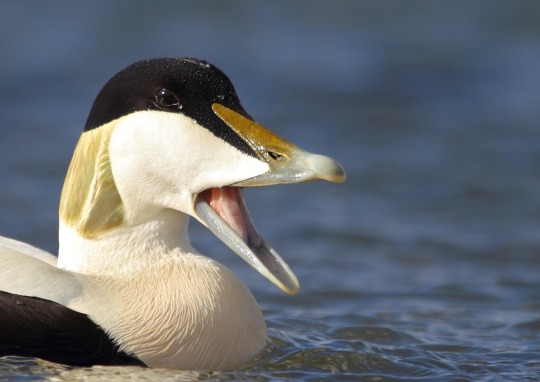#Common eider
Explore tagged Tumblr posts
Text

Common Eider (Somateria mollissima)
#Somateria mollissima#common eider#COEI#eider#eider duck#St. Cuthbert's duck#Cuddy's duck#duck#sea duck#seaduck#illustration#bird#art#drawing#bird art#bird illustration#bird illustrator#bird artist#maine#maine artist#maine illustrator#downeast#downeast artist#design#maine birds#animal art#animal drawing#animal#nature#wildlife
149 notes
·
View notes
Text
My brother and i unified my passion for birds with The Terror by assigning birds to the characters.
So far there are:

Black grouse for Sir John because of the general facial expression, color and shape, and the bird’s stubborn personality.

Common eider duck for Crozier because in my mind he is a duck and this duck’s natural habitat is in the arctic.

Snowy albatross for Tom Blanky because he’s cool like that. The pelican was a runner-up but their habitat is too far south.

Common gull for Hickey because he generates common gull energy. My mother contributed greatly to this choice.

Little auk or alle alle for Silna because of the bird’s way of life(living in packs/colonies, non-migratory nature, etc.) Originally, i wanted to choose the atlantic puffin but then i saw the little auk and knew it was the one.

Finally, the Tundra bean goose for Goodsir because, i mean, Goodsir? More like Gooser.
There are more, but i think six is enough for one post.
#franklin expedition#sir john franklin#the terror#the terror amc#thomas blanky#jfj#francis crozier#cornelius hickey#silna#silna the terror#harry goodsir#birds#wild birds#black grouse#common eider#arctic birds
47 notes
·
View notes
Text




Eiders bob along on a blustery winter’s day | 01.05.25
#the sea#landscape#common eider#birds#birding#my photography#mother nature#birdblr#birdwatching#cape cod
44 notes
·
View notes
Text

Bird men smoking #1
#hi dearcarnifex nation#dearcarnifex#my art#art#anthro#illustration#1980s#artists on tumblr#character design#oc: leander#oc#oc art#original art#original character#eider#common eider#duck#bird#furry#furry artist#furry art
80 notes
·
View notes
Text

Common eider (Somateria mollissima)
277 notes
·
View notes
Photo

A common eider (Somateria mollissima) in Northumberland, UK
by Jan Willem Steffelaar
#common eider#eider#ducks#waterfowl#birds#Somateria mollissima#somateria#anatidae#anseriformes#aves#chordata#wildlife: uk
799 notes
·
View notes
Text

Common Eider, for school.
#birds#common eider#bird art#digital painting#bird#clip paint studio#artists on tumblr#(pretending that i post my own art more than twice a year max)#my art#trying to post these online because i've enjoyed painting them and i'm still feeling good about them#i could've continued this till insanity but i have to do like 20 of these portraits XDD#why am i doing this to myself... 🤔 for love. of birds..
18 notes
·
View notes
Photo

Common eider, male . . . Indian River Inlet . . . 12/11/20
252 notes
·
View notes
Text
BOTD: Common Eider

Photo: Tobias Verfuss
"A big, lethargic, heavy-bodied duck of northern coastlines. Often seen floating offshore in flocks of up to several thousand birds. Sociable in breeding season also, and often nests in colonies. Eider down, famous for its insulating qualities, is used in large amounts in the nest lining of these ducks, helping to keep the eggs warm in frigid northern climates. In some places, such as Iceland, the down is harvested commercially at coastal 'eider farms,' where the wild birds are encouraged to nest in sheltered nooks built for them."
- Audubon Field Guide
#birds#common eider#birds of north america#north american birds#ducks#waterfowl#eiders#sea ducks#seaducks#birds of the us#birds of canada#birding#birdblr#birblr#bird watching#bird of the day#Somateria mollissima
36 notes
·
View notes
Text




Common Eiders
(8-24-24)
#this was the bird I wanted to see the most during my trip#take.flight#my photography#birding#wildlife photography#common eider
7 notes
·
View notes
Text

Eider ducks can reach flight speeds of 113 km/h (70 mph)
(Common eider, female plumage)
#photography#art#outdoors#nature#digital art#animals#wildlife#adventure#outdoor#birds#ducks of tumblr#duck#ducksofinstagram#common eider
22 notes
·
View notes
Text

Common Eider (Somateria mollissima)
© AUDEVARD Aurélien
8 notes
·
View notes
Text

What I have is what you need, and I’m never gonna give it to you
#oc: Leander#oc: Marion#my art#art#artists on tumblr#original character#oc#furry#digital art#bird#common eider#eider#waxwing#bohemian waxwing
42 notes
·
View notes
Text

Common eider or Somateria mollissima
The common eider, also called St. Cuthbert's duck or Cuddy's duck, is a large sea-duck that is distributed over the northern coasts of Europe, North America and eastern Siberia.
Available now on Redbubble
#common eider#redbubble#encyclopedia#bird#duck#vintage#vintagrafica#scientific illustration#bird art#birdwatching
5 notes
·
View notes
Text
Round 2 match 7B


The Common Eider primarily nests in the Arctic regions of North America and Europe but can also be found nesting further south along the shores of Hudson Bay and the coast of Atlantic Canada. Common Eiders tend to nest in large colonies, which allow for cooperative reproductive strategies. For example, once they hatch, large groups of ducklings may be cared for together by groups of adults, rather than in individual family groups.
Emperor Geese are ground-nesting birds and, within the North American portion of their range, nest exclusively in Alaska. While all species of geese, ducks, and swans have “precocial young,” meaning the young are relatively well-developed and capable at the time of hatching, Emperor Geese take this a step further. The goslings leave the nest within just a few hours of hours of hatching and are ready to begin foraging for food. Goslings are grey all over with stubby black bills.
#common eider#emperor goose#ducks#geese#birds#baby duck poll#ducklings goslings cygnets#tumblr polls#tournament poll#round 2
2 notes
·
View notes
